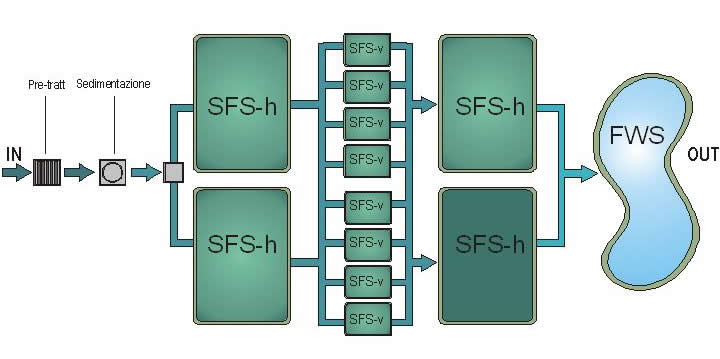Hybrid Constructed Wetlands
Hybrid (or multistage) constructed wetland is intended when different wetland solutions (HF, VF, FWS or other advanced technologies) are combined together either to meet more stringent water quality standards or to occupy less area.

In the design of a constructed wetland system, the choice of plant configuration depends on many factors: the main ones are the depurative goals, the morphology of the area and the type of wastewater.
As you can see from descriptions reported in the relative pages, each typology of a constructed wetland (HF, VF, FWS systems) presents particular characteristics from the point of view of functioning and depurative efficiencies. It is obvious, therefore, as in design phase, according to the restrictions imposed by the particular situation (available areas, morphology, characteristics of the wastewater, requested effluent's quality objectives), the choice of combining different plant typologies comes to be often recommended (if not obliged). A hybrid system, in fact, can be able to harness the potentialities of each typology of constructed wetland strongly reducing negative aspects of single components.
The possible solutions are numerous; in the following, some of them are described.
VF + HF : system with vertical subsurface flow disposed of in two basins fed in a discontinuous alternate way, followed by a horizontal subsurface flow system; the introduction of the horizontal subsurface flow system has the aim of obtaining a more efficient de-nitrification of the effluent of the vertical system.

HF + VF : horizontal subsurface flow system, followed by a vertical subsurface flow system disposed in two basins fed in discontinuous alternate way; the stage with horizontal subsurface flow has the function of removing most of the organic load and the suspended solids remained after the primary sedimentation; the stage with vertical subsurface flow ensures a high oxidation and an efficient nitrification without having undesired problems of clogging. This scheme can be accomplished by recycling the effluent at the beginning of the system, so to obtain more efficient denitrification.

HF + VF + HF + FWS : system with horizontal subsurface flow, followed by a vertical subsurface flow system, by another horizontal subsurface flow system and by a free water surface system; the ulterior horizontal subsurface flow system realizes the de-nitrification of the wastewater, while the free water surface system, beside completing the removal of nitrogen components, further accomplish the removal of microbial load.

Multistage system: a "tailor-made" solution
Multistage systems bring a key concept: nature-based solutions are not "plug and play" solutions, but they have a great potentiality to be merged according to with different needs. Essentially, a multistage system must be seen as a "tailor-made solution", i.e. a way to optimize the design function of different effluent water quality targets. the following table (in Italian) shows how the size of CW WWTP can be optimized combining different CW solution instead to use a single one, as a function of different size and type of discharge allowed by Italian law (water body "corpo idrico" or soil "suolo").


Areal footprint (m2/PE) for different constructed wetland combinations (elaboration Iridra). Green, yellow, and red boxes report if the solution is suitable, suitable only in particular conditions, or not suitable, respectively.

Scheme of the multistage CW of the Dicomano WWTP Dicomano (FI), it serves 3500 PE and was designed by IRIDRA

